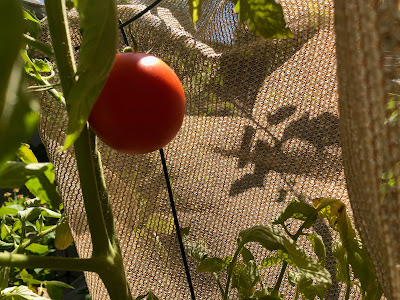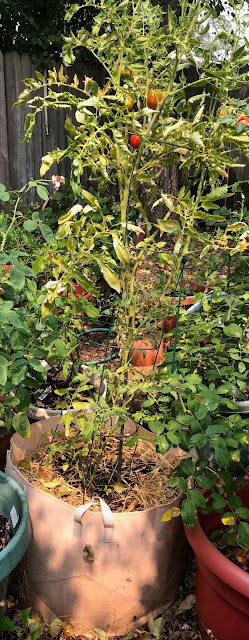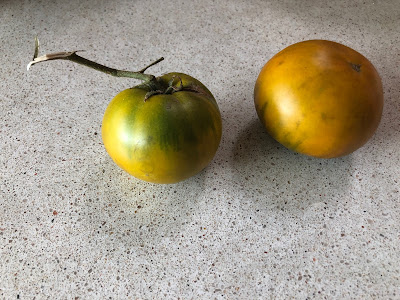
What can tomato growers learn from all this?

|
|
If there's one photo that sums up the 2020
growing season, it's this one: Tomato behind
shade cloth in mid-August. (Photos:
Kathy Morrison)
|
Warning! Today I'm going to explore a sensitive topic: The tomato-growing season of 2020.
What, you say, why remind us of all that anguish?
Well, it was a learning experience, that's for sure. Even gardeners who had good-to-great tomato seasons ran into a few bumps. (112 degrees!!!) And we all feel a little sad when we pull out that last tomato plant, but that doesn't mean we should immediately erase the season from memory.
As baseball fans like to say, wait 'til next year!
Looking ahead, the biggest concern is the increasing number of hot days. As Debbie reported Wednesday , we had a record 125 days of 90-degree (or hotter) weather. That's a full four months, folks, two weeks more than the previous record of 110 in 1984. We need to acknowledge this kind of summer heat probably is here to stay. It's no longer an aberration.

|
|
All in all, this Big Beef was
pretty happy in its 30-gallon grow pot.
|
-- Prep that soil as early as possible. Run a soil test in winter on the preferred tomato location. Add nitrogen, compost and worm castings early enough that the soil is ready when planting weather is right.
-- Which reminds me: Assuming it's not pouring rain for a month -- as if! -- plant at least a few tomatoes in late March or early April. Then roll out the rest over a month. If there are heat spikes in June, which is an increasingly good bet, at least some of the tomatoes will be producing.
-- Fight spider mites early and often. Spray everything down with water, including pathways, at least every other day as the weather starts to warm up, whether or not spider mites seem to be present. (They are, most likely.) The longer I kept them at bay, the better chance my tomato plants had to grow and produce.
-- Go after weeds early, too. My community garden plot is along a fence, and outside the fence is field and a ditch -- perfect hiding places for overwintering pests. I really need to attack the weeds along the fence early, before most of the summer garden is planted.
-- Put in even more pollinator plants. I typically have zinnias, sunflowers and an African blue basil plant near my vegetables. This year, I upped the pollinator options by adding alyssum, chamomile and fennel transplants, and I dumped an entire package of mixed basil seeds into a 2-foot spot. That basil was just for the bees and other beneficials -- I let it flower and it's still going strong. The good bugs get even more sources next year, definitely.
-- Have plenty of shade cloth on hand before the heat spikes. It was sold out in many places by July, when I realized I could use a LOT more of it. I improvised with a wrecked lace tablecloth and some towels, but shade cloth works for a reason: It's tough but permeable. It also can be rolled up and put away for next year. I even washed some of mine on delicate in the washing machine, and it came out fine.

|
|
These are a couple of the Green Cherokee tomatoes.
Interesting, but ultimately not worth the time commitment. |
-- Grow pots can work for tomatoes. This was another experiment for me this year: Would a full-size tomato produce in a 30-gallon fabric grow pot? It took a lot of potting soil and compost to fill that pot, but the Big Beef I put in it did pretty well, considering the weather. Also, I was home all the time to keep it watered. I also mulched it heavily with straw, and surrounded it with several potted roses to keep the soil from drying out too fast.
-- Grow Better Bush again. It's by far the best container plant I've tried, and it put up with the weather beautifully. Patio Yellow was another good one in a pot. Gee, I really need to check my seed supply, before I pack everything away and the tomato memories fade completely.
If any readers would like to share what they learned in tomato gardening this year, write to Debbie and me at sacdigsgardening@gmail.com.
Comments
0 comments have been posted.Sacramento Digs Gardening to your inbox.
Sites We Like
Garden Checklist for week of May 12
Get your gardening chores and irrigation done early in the day before temperatures rise.
* Plant, plant, plant! It’s prime planting season in the Sacramento area. Time to set out those tomato transplants along with peppers and eggplants. Pinch off any flowers on new transplants to make them concentrate on establishing roots instead of setting premature fruit.
* Direct-seed melons, cucumbers, summer squash, corn, radishes, pumpkins and annual herbs such as basil.
* Harvest cabbage, lettuce, peas and green onions. This heat will cause leafy greens and onions to flower; pick them before they bolt.
* In the flower garden, direct-seed sunflowers, cosmos, salvia, zinnias, marigolds, celosia and asters.
* Plant dahlia tubers. Other perennials to set out include verbena, coreopsis, coneflower and astilbe.
* Transplant petunias, marigolds and perennial flowers such as astilbe, columbine, coneflowers, coreopsis, dahlias, rudbeckia and verbena.
* Keep an eye out for slugs, snails, earwigs and aphids that want to dine on tender new growth.
* Feed summer bloomers with a balanced fertilizer.
* For continued bloom, cut off spent flowers on roses as well as other flowering plants.
* Got fruit trees? If you haven't already done so, thin orchard fruit such as apples, peaches, pears, pluots and plums before they grow too heavy, breaking branches or even splitting the tree. Leave the largest fruit on the branch, culling the smaller ones, and allow for 5 to 6 inches (or a hand's worth) between each fruit.
* Thin grape bunches, again leaving about 6 inches between them. For the remaining bunches, prune off the "tail" end, about the bottom third of the bunch, so that the plant's energy is concentrated in the fruit closest to the branch.
* As spring-flowering shrubs finish blooming, give them a little pruning to shape them, removing old and dead wood. Lightly trim azaleas, fuchsias and marguerites for bushier plants.
* Add mulch to the garden to help keep that precious water from evaporating. Mulch also cuts down on weeds. But don’t let it mound around the stems or trunks of trees or shrubs. Leave about a 6-inch to 1-foot circle to avoid crown rot or other problems.